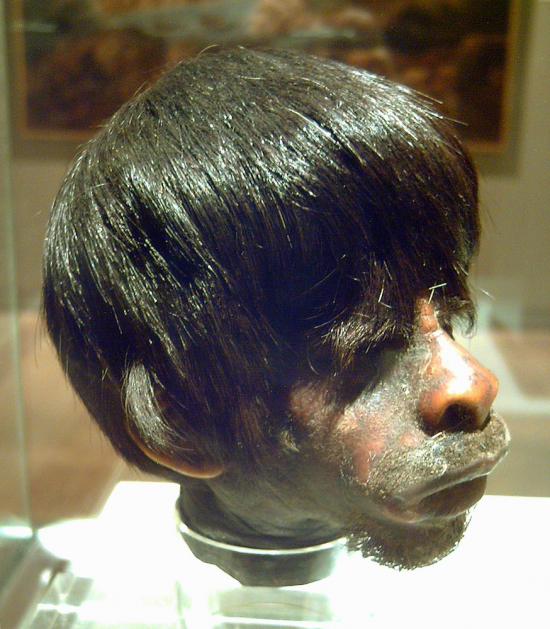The biggest organ of our body is the 2 square metre wide skin that covers it.
Occasionally magazines about scientific curiosities provide surprising news about the skin and its amazing qualities: for example, it keeps on dying and being renewed. This turns us into inexhaustible sources of dead cells – about 30.000 per minute, more than 50 percent of the dust that settles in our houses.
The pages of women’s magazines reveal all the best tricks to keep our skin beautiful, healthier and more glowing: vitamin A, D, C, E, and an endless list of compresses and creams of any kind – moisturizing, exfoliant, cleansing, antioxidant, and so on.
This article is going to deal with the skin exploring three very peculiar items: shrunken heads, necropants, and books bound in human skin.
1. Tsantsa
According to the majority of cultures, face and head are the seat of the spirit. Therefore, when an enemy is killed, to take possession of his head means to take possession of his soul, his strength, and to prevent him from taking revenge.
The Shuar people (Jivaros), that still live between Ecuador and Peru, were undisputed masters of the ancient art of shrinking the heads of enemy warriors to the size of a big orange. The ritual process which led to the creation of a tsantsa was complex but ingenious: a cut was made from the nape of the neck to the top of the head, and the skin was carefully removed from the entire skull, that was subsequently thrown away. The skin of the head was turned inside out in order to sew eyelids and lips from the inside; then it was turned inside out again and some red-hot stones were rolled inside it in order to burn the remnants of soft flesh. The head boiled for a couple of hours until it was reduced to a quarter of its original size. The whole process was celebrated with feasts, balls and songs.
Nowadays Shuar men still make tsantsa and sell them to tourists, but they only use animal skins.
2. Necropants
Easy money? Not exactly. In Iceland, during the Middle Ages, people could become rich using a reliable but rather complex method. First of all, you had to find a friend that accepted the idea of being exhumed after death. After having dug up the corpse, you had to skin the whole lower part, from the waist down. As soon as you put them on, these macabre trousers made of flesh would perfectly fit your legs. A coin stolen from a widow should be introduced in the scrotal sac together with a magic symbol (nábrókarstafur) written on a small piece of paper. In this way, the scrotum would miraculously keep on filling with new coins. And how to get rid of the trousers? You should bequeath them to somebody else, that would enter the pants a leg at a time, while the previous proprietor came out of them… on penalty of eternal damnation. A latex reproduction of the necropants is on display at the Museum of Icelandic Sorcery and Witchcraft in Hólmavík.
3. Anthropodermic bibliopegy
A book bound with the tanned skin of a human being is an idea that may be perceived as inhuman today. We are likely to relate it to satanist grimoires or, even worse, to concentration camps. And yet most of the real specimens that have come down to us testify to a completely different attitude. The tradition of binding books in human skin dates back at least to 1400, and its meaning was anything but macabre: in two out of three cases it was a tender tribute to a deceased person, a way to commemorate or to express one’s debt of gratitude towards him/her. There were books covered in one’s best friend’s skin; a father on his deathbed might choose this brave solution to leave his legacy to his heirs, as if he was saying: “I leave you all that I was in life”. Some anatomists used to bind their texts with the skin of the corpses they had dissected – a way to acknowledge the fundamental contribution of those nameless bodies to the progress of science. The anthropodermic bibliopegy as a means of degradation and punishment was reserved only to the most hated and most famous murderers that received this punishment in addition to death penalty.

